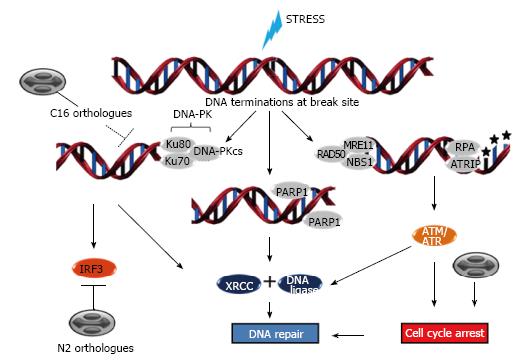Copyright
©2014 Baishideng Publishing Group Inc.
World J Clin Infect Dis. Nov 25, 2014; 4(4): 27-40
Published online Nov 25, 2014. doi: 10.5495/wjcid.v4.i4.27
Published online Nov 25, 2014. doi: 10.5495/wjcid.v4.i4.27
Figure 5 DNA damage responses and poxvirus infections.
DNA breaks may be caused by many different sources. At sites of DNA double strand breaks (DSBs), DNA-PK is recruited by Ku proteins and induces DNA repair through XRCC4 and DNA ligase 4; DSBs also lead to the activation of the major interferon regulatory factor, IRF3. Upon DSBs occurrence, ataxia telangiectasia mutated (ATM) is recruited by the MRE-11-Rad50-NBS1 (MRN) complex to sites of broken DNA where they induce repair by XRCC2/3 and DNA ligase 1. ATM also controls cell cycle arrest which facilitates proper function of the DNA repair mechanisms. Upon single strand breaks, ataxia telangiectasia and Rad3 related (ATR) or poly (ADP-ribose) polymerase 1 (PARP1) are recruited to lesions sites and are activated, resulting in phosphorylation of downstream substrates, control of cell cycle arrest and/or repair of DNA lesions by XRCC1 and DNA ligase 3. Poxvirus infections affect cell cycle progression arresting cells in G2 phase. They also encode C16 orthologues that bind to Ku70, blocking DNA-PK recruitment to broken DNA sites, and N2 orthologues, that inhibit IRF3-dependent innate immune responses. DNA-PK: DNA-dependent protein kinase; DNA-PKcs: DNA-dependent protein kinase catalytic subunit; RPA: Replication protein A.
- Citation: Leão TL, da Fonseca FG. Subversion of cellular stress responses by poxviruses. World J Clin Infect Dis 2014; 4(4): 27-40
- URL: https://www.wjgnet.com/2220-3176/full/v4/i4/27.htm
- DOI: https://dx.doi.org/10.5495/wjcid.v4.i4.27









